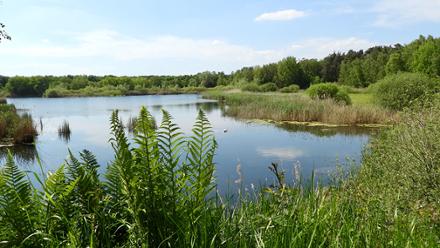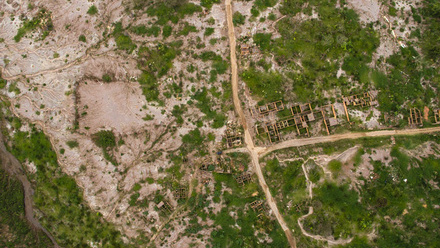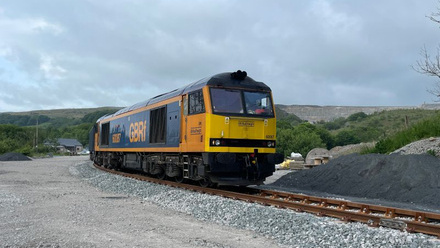How UK mineral operations are undertaken
This guide explains the principal steps and operations involved in exploration, extraction, processing, and distribution of minerals.
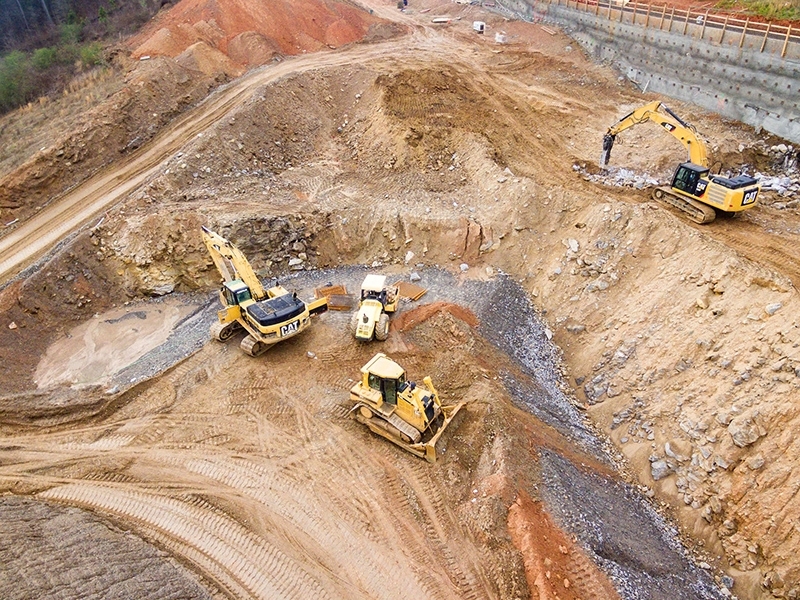
There are three main stages in any mineral operation - finding minerals and getting permission for extraction, extraction and processing, and restoration of the site to suitable subsequent uses.
Before extraction
Before any extraction can take place, the prospective mineral operator must -
- locate economically viable mineral deposits, secure access by agreement with the landowner through lease or purchase of the site, and undertake site investigations and, usually, environmental impact assessment, and
- apply for and secure the necessary planning permission and any environmental permits that are required.
The main steps in identifying and evaluating a potential site for mineral working site and securing the necessary permissions are -
- exploration
- establishing the mineral's workability and economic quality
- undertaking a preliminary assessment of whether the site is likely to be acceptable in planning terms
- securing mineral working rights
- planning a working scheme for possible extraction and managing the site, and
- applying for the necessary planning consent and environmental permits.
Exploration
The geology of England is fairly well known so target areas for possible mineral working can be fairly readily identified. The priority for investigation is normally given to sites or areas where permission for extraction is more likely to be secured because these have previously been identified by Mineral Planning Authorities in statutory development plan documents as being generally suitable for properly controlled mineral working. Mineral deposits are investigated by -
- digging trial pits or drilling and recovering samples and testing these to determine whether they have the right physical and chemical characteristics, and the types and amount of processing that would be required, and
- geophysical surveys - measuring the electrical responses of the rocks and contained water, gravitational attraction and, in some cases, the responses to the passage of vibrations.
Most exploration for aggregates is short term with minimal impacts on the local environment and is therefore regarded by the regulatory authorities as ‘permitted development’ that can proceed after simply notifying the mineral planning authority (MPA). But there are exceptions that require separate planning permission notably where deeper drilling of rock deposits such as for investigation of oil and gas reservoirs or metalliferous deposits at depth, is needed particularly near environmentally sensitive locations.
Many site investigations to establish whether minerals are present are short lived, and fairly unobtrusive such as digging trial pits. However, for some minerals such as oil and gas much deeper drilling is required and rigs may be in place for long periods.
The ground is also investigated through non-invasive geophysical surveys such as measuring physical properties of the ground such as resistivity or electromagnetic conductivity.
Establishing whether a site is suitable for extraction
When a deposit has been adequately investigated and the thickness, lateral extent, volume, tonnage and quality of mineral is known the costs of working, processing, transport and market value of products can be calculated to establish whether extraction would be economically viable. However, that does not mean that permission for extraction will be given.
The site must be suitable in environmental and social, as well as economic, terms. Therefore potential impacts are, in most cases, investigated in a process known as environmental impact assessment (EIA). While the formal preparation of an Environmental Statement (ES), drawing together the results of the EIA, will come later as part of the planning application necessary if it is decided to go ahead, at this early stage the prospective operator will need to consider a range of factors that will determine whether it is worth going ahead with the project, and, if so, the constraints and costs that will have to be accommodated.
EIA considers matters such as -
- nuisance from dust, noise, vibration, and traffic
- discharges to surface water
- changes to flow and quality of underground water
- the nature and appropriate management of waste from the extraction operations
- visual intrusion
- impacts on habitats, biodiversity and protected species
- impacts on cultural heritage - ancient monuments and archaeological sites
- potential instability of the ground, and
- loss of public access to land and footpaths.
Some of these matters will be the subject of their own regulatory controls, such as noise and dust emissions (public health), water discharges and water system flows and quarry/mine waste management (regulated by the Environment Agency) and impacts on habitats and heritage (regulated through the planning system). All the other matters are normal ‘material considerations’ under general planning law.
The necessary information is secured by compiling existing information about the site and the surroundings and undertaking site surveys. These may consider ecology, archaeology, water quantity and quality and climate, some of which require monitoring over a suitable period of time. The information is compiled and analysed to identify potential significant environmental impacts and to propose ways in which these could be overcome or reduced to an acceptable level. The operator usually commissions this work from experienced independent consultancies and other experts often in consultation with the MPA's own advisers.
The resulting environmental statement (ES) is in due course considered by the MPA as part of the process of considering the eventual planning application. It may require the operator to present additional information on some topics before the application is determined. Where matters impinge on the interests of other regulators, such as the Environmental Health Department or the Environment Agency, they will be consulted. Where the ES touches on matters separately regulated by the Environment Agency, it will be taken into account in decisions on applications for the relevant permits and consents. Is should not be necessary to produce separate assessments for those purposes.
Securing mineral working rights
Mineral operators must secure access to land for mineral working by either buying it or leasing the mineral rights. This usually happens only if the landowner is willing to sell or enter into an arrangement, although a legal provision under the Mines (Working Facilities and Support) Act 1966 does allow for compulsory purchase in certain limited circumstances in the national interest. Some sites that might be suitable for mineral extraction in social, economic and environmental terms remain unavailable because landowners do not wish to sell or lease rights. In such cases operators may sometimes have to consider alternative sites that are less suitable.
The timing of the acquisition of access and working rights will be a matter for negotiation between operators and landowners. Where they do not already own the land operators will want to have established that there is a viable prospect to exploit before making any substantial financial commitments. And in view of the uncertainty over obtaining planning permission they may agree with landowners' options to lease or purchase making full payment or a completed lease conditional on obtaining permission.
Planning the approach to possible extraction
This includes assessment of -
- stripping, handling and storage of soil and geological materials resting above the useable mineral
- methods, depths and directions of extraction of mineral, including safe working in the management of slopes and tips, noise, dust and vibration modelling for impact on potentially sensitive receptors outside the site, fly-rock modelling where blasting is required, and stockpiling of mineral for procession on site or loading onto road or rail vehicles
- water management - pumping, storage of liquid production waste ‘tailings’, and discharges
- mineral and other waste management, including a mineral waste hazard assessment and site waste management plan
- haulage and handling of materials within the site
- methods of processing and location of machinery, electrical power access, fuel storage and other equipment for efficient site operation and the minimisation of visual impact on the surrounding area
- control and reduction of emissions
- access for transport, usually road but occasionally on large sites rail and on rare occasions by inland waterway or sea
- arrangements for dust control on site and adjacent roads and load sheeting for road vehicles
- suitable haulage routes outside the site and
- options for decommissioning the working plant, if necessary rehabilitating and then restoring the site to an appropriate, acceptable after-use.
Applying for planning consent and environmental permits
The prospective operator must apply to the relevant MPA for planning permission and to the Environment Agency for permits covering discharges to air and water and handling of mining waste. Commonly, the application for environmental licensing is made after planning consent has been given and should use common information in a single ES, because both steps are costly.
Both types of consent must be in place before any operation can commence. Each planning permission and environmental permit is accompanied by legally enforceable conditions that must be observed during operations at the site. Environmental permit conditions take precedence over planning conditions although planning conditions may sometimes be more stringent than environmental conditions. Both continue in force while the permitted activities continue.
In the case of planning conditions they will extend beyond the cessation of extraction where they govern the decommissioning of the site and its restoration and aftercare. In planning law the whole process governed by the permission is an ‘act of development’, and the conditions are subject to regular monitoring, for which fees are payable, and, if necessary, enforcement. In addition, there is a statutory process of periodic review at 15 year intervals, during which old conditions are reviewed and may be altered to bring them into line with current good practice.
Where new conditions adversely affect the financial viability of the permitted extraction to an unreasonable degree, for example by being more stringent than hitherto, compensation may be payable by the MPA. This is because the original permission conveyed a property right, and that cannot lawfully be removed without compensation.
During extraction
The planning permission for an extraction operation is implemented when work commences at the site. Each involves -
- site preparation
- extraction
- handling of materials within the site
- dewatering and water management
- primary and secondary processing of the mineral
- dealing with by-products
- transporting products from the site, and
- managing non-operational areas within the site.
Site preparation
Preparation of the site includes local improvements to road access, sometimes by constructing a dedicated separate access road, and securing alternative public footpaths if required, construction of the processing plant, offices and maintenance workshops, erecting secure fencing and posting warning signs at site margins; and the planting of tree screens or construction of marginal ‘bunds’, these are mounds – often used also for the storage of soils and overburden pending later replacement in a restoration scheme, to help reduce the visual impact and noise emissions from subsequent operations.
If extraction is permitted, work is undertaken to make the site ready, including improvements to road access and erection of fencing and planting of tree screens at site margins. Sometimes hedges and footpaths have to be relocated.
In some cases, archaeological excavations are undertaken either before the ground is broken or if unexpected finds are encountered.
Extraction
Minerals are worked by surface quarrying, underground mining or liquid/gaseous extraction through wells – ‘boreholes;. Most minerals are normally worked in England by surface quarrying because it is less costly than underground mining. That is economically viable only for high value minerals especially where these occur at depths greater than those that are safe or economic for quarrying. Extraction through wells is undertaken for oil and gas but also for salt - water is passed into the ground so that the mineral dissolves and can be pumped out as brine.
Surface extraction starts by carefully and separately removing soil and subsoil and storing it for later use in landscaped and planted bunds at the margins of the working. This helps to reduce environmental impacts but also keeps it away from land to be quarried. Soil movement is carefully controlled to preserve the soil's structure for later re-use, avoiding in particular unduly wet or frosty weather and excessive handling. Any unusable geological material - ‘overburden’ - lying above the economic mineral is also removed and placed in bunds or tips for later use in restoration.
Initially the topsoil and subsoil is lifted from part of the site and is stored in bunds usually at the site margins and is added to as the operation progresses. These are seeded with plants and trees can be planted.
Dewatering and water management
Underground operations and most surface quarries work to depths below the groundwater level and therefore have to be dewatered by pumping - although some shallow sand and gravel deposits are extracted from beneath water. Discharges of water have to be managed carefully to prevent excessive lowering of the water table in the vicinity of the quarry or discharges of water containing suspended solids into surface water bodies with consequent effects on ecosystems, crops or water quality and supply. Water is stored in ponds to allow solids to settle out before being discharged.
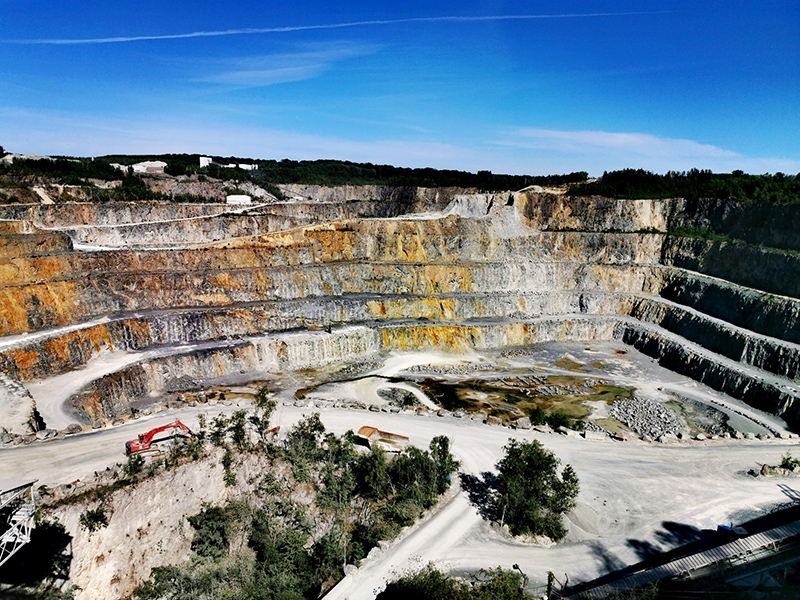
Extracting the mineral
The method of mineral extraction depends on the nature of the mineral deposit.
Thus hard rock requires drilling and blasting while loose sand and gravel is often extracted using bucket and shovel, but in a few cases may be dredged from a water-filled pit. Some deposits of intermediate strength may require selective, rather than regular, blasting.
Unconsolidated sand and gravel and clay can be dug directly from the working face. Many sand and gravel deposits are thin so the excavations are relatively shallow.
Hard rock can usually be worked to much greater depths, So quarries are worked in a series of levels or ‘benches’ going progressively deeper while preserving safe and stable slopes. The direction of working is influenced by the need to maintain stability of faces, by haulage distance from the plant and by the need to control noise.
Handling of materials within the site
Excavated material is commonly lifted by front-end loaders at the face and then placed into large tipper trucks or onto field conveyor systems to be carried to the processing plant, but at some workings may loaded directly into the processing plant. Designated haulage roads are included in the design of the quarry and may be relocated from time to time as working of the site progresses.
Primary and secondary processing
Minerals have to meet industrial specifications that define the required mix of grain sizes, absence of any deleterious materials and other mineralogical, chemical and physical characteristics, as appropriate. Key steps in primary processing of most minerals are to -
- crush the material, if necessary in one or two stages or sometimes, as with clays, to shred the material
- if necessary, sort the material using a set of large industrial ‘sieves’ in a step known as ‘grading’ to separate out the constituent grain sizes so that these can be selectively re-mixed in the correct proportions for each intended use of the material, and
- remove material that is too fine grained, excess water if present, and any deleterious materials that must be separated from the useable product.
However, some lower-grade material is sold without significant processing - ‘as dug’, for instance as construction fill used for fairly undemanding purposes such as levelling and stabilising sites.
The scale and nature of the processing plants depends on the type of mineral, the nature of the products and the scale of the operation.
Much of the aggregate that is extracted is used in products such as ready-mixed concrete, coated with bitumen to produce asphalt in roads and other surfaces and concrete blocks. Special plant is need for this secondary processing which may be located at the quarry or elsewhere.
Ready-mixed concrete and road asphalt are time-sensitive products and proximity to markets is an important consideration in locating their processing plant. Clay extraction is often co-located with brick, pipe or tile works. Oil and gas are usually carried elsewhere through a pipeline for processing, which requires specialist and normally high-capacity plant.
Dealing with other excavated materials
In addition to overburden stored before extraction, by-products arise during extraction and processing. Some of these can be sold but others must be stored on site. These consist of -
- soils and overburden removed and stored for eventual use in site restoration
- unsuitable materials found within, or between layers of, the usable mineral deposit which are placed in tips; and
- fine grained material produced during processing -‘tailings’ - which is placed in ponds often called ‘lagoons’.
Tips and lagoons are not needed for all mineral operations but, where they are, construction must be undertaken carefully and these structures have to be checked regularly, and maintained if necessary, to ensure that they are effective and safe.
Some material from above or within the mineral deposit together with residues from processing may be un-saleable, at least in the short term. The coarser materials go to tips and the finer materials to settling ponds to reduce the amount of suspended solids to a level where it is safe to allow the water to enter water courses.
Transporting products from the site
Solid products are carried to other locations for direct use or for manufacturing of value-added products. For aggregate minerals, this is mainly undertaken by heavy lorries over not more than about 35-40 km or so from the quarry for reasons of cost. But some value-added products using aggregates such as coated stone, and other higher priced minerals can be carried further by road, subject to the daily time constraints of just in time delivery to live construction operations.
However. there are environmental and economic advantages in using bulk transport for heavy materials over longer distances. Some of the larger, high capacity quarries are rail linked and a few have access to marine or river wharves. The amount carried by rail or water is limited by the overall capacities of railways and wharves for handling freight, and the reach of these fixed transport networks in relation to the wide dispersal of mineral extraction determined by geology.
Lorries may be driven by employees of the mineral operator but are now often run by independent contract drivers. However, the mineral operator remains responsible for ensuring that planning conditions and agreements concerning transport are observed such as pre-load parking, load sheeting and following agreed routes keeping traffic off narrow roads or away from residential areas.
Managing non-operational areas within the site
Some areas within the boundaries of the planning permission of the site may not be opened up for working for some time, may not be worked at all because of the absence of suitable mineral, or for environmental and landscaping reasons. Parts may remain in use for agriculture or livestock and these and other areas also offer opportunities for contributing to quarry biodiversity action plans.
Well managed trees and hedges which screen sites may also make significant contributions. In some situations, working of certain sections of quarries may be temporarily delayed, for example, to avoid nesting areas of sand martins in sandpits and nesting sites of peregrine falcons on ledges in rock quarries. As a condition of the permission, sensitive habitats may even be relocated where this can be done without losing the scientific value, in order to move them out of the path of mineral working.
Mineral extraction is essentially a disruptive process but, even so, it is possible to co-exist with wildlife because parts of the site will not be affected at various stages in the operations. These can be managed to contribute to conservation objectives.
Underground mining
Underground mining has been undertaken in the past for many minerals. However, developing underground mines on any large scale and in accordance with modern safety standards is expensive and can now usually only be justified for high value minerals that occur too deep in the ground to be quarried.
Therefore, few new mines have been contemplated or opened in the UK in recent decades, though existing mines continue to be operated at varying scales for products such as coal, building stone, salt, potash, gypsum and vein and metalliferous minerals.
Deep mines are usually developed through vertical shafts, which require a pit head and winding gear, and shallower mines generally through a horizontal adit or an incline that can be negotiated by vehicles. The mine is developed as a series of galleries that follow the mineral bearing levels leaving intervening rock in place. Waste rock may be carried to the surface and be placed in tips but increasingly waste is stowed in worked out areas of the mine.
In some mines some primary processing may be undertaken underground but generally processing, support and transport facilities are located at the surface, usually close to the mine entrance.
Mining, particularly shallow mining, gives rise to underground voids that can collapse as time passes, and needs to be designed carefully to avoid subsidence that damages the ground surface and properties, as has occurred in a number of areas of historic mining not carried out to modern engineering standards or safeguarded against later unauthorised extraction from supporting rock pillars.
Deep mining is less likely to cause surface subsidence, although it can give rise to slight general down-warping of the surface, which needs to be taken into account when a mine is planned. Particular care is needed where naturally occurring underground faults in the ground are encountered, to make sure that past movement is not reactivated.
Fluids and natural gas
Fluids such as oil, gas and brine are extracted through wells and are carried by pipeline to storage and processing facilities that may be some distance away. Thus, operations can be relatively unobtrusive at the point of extraction.
The principal disturbance associated with oil and natural gas is caused by deep exploratory and production drilling which requires a large rig to be in place for some time, but that can be removed once the well is established, and the laying of the pipeline away from the site.
After extraction
After the site has been worked, a number of steps are taken -
- restoration, either progressively during extraction or wholly after extraction to a condition suitable for a subsequent appropriate use agreed with the Mineral Planning Authority
- aftercare
- afteruse, and
- completion and ‘signing off’ of operations.
Restoration
All mineral workings are required to be restored to a condition suitable for beneficial afteruse. The restoration plans, and the subsequent use are agreed with the Mineral Planning Authority (MPA) in the planning permission either in detail or in principle. The conditions may be fully prescriptive if the site is a short term operation.
If the site is likely to be in operation for many years conditions are usually more flexible, identifying an afteruse and requiring the precise scheme of restoration to be agreed with the MPA at a future date. This is because economic, social and environmental circumstances may change.
Restoration and associated conditions are subject to the regular review by the MPA to make sure that these also conform to current good practice. Mineral operators are usually covered by a trade association restoration guarantee or a direct restoration bond to ensure that restoration takes place even if the company ceases trading. The commitment to and quality of restoration has in recent years become a significant element in mineral operators' reputations, and can be influential in the approach of MPAs to the grant of further permissions.
The restoration process depends on the nature of the mineral working operation and the agreed subsequent use of the site. Small relatively shallow excavations are commonly in-filled with inert material from within the site, such as stored overburden or mineral or inert construction waste from elsewhere. Stored sub-soil and top-soil are then carefully spread over the site before replanting or seeding takes place.
Excavations that extend below groundwater level will fill with water when pumping ceases. Margins and residual islands can be landscaped as lakes for amenity uses such as sailing or fishing, nature conservation or water storage purposes.
It is usually impractical to infill large deep dry excavations except for the landfilling of waste, so in cases where landfill is not the after-use these are either restored at a lower level by spreading sub-soil and top-soil on the quarry floor. More often these are landscaped by selective excavation and blasting during the closing stages of quarrying, and visually improved by seeding or planting on the benches and floor of the quarry. A few have been left for water storage. Restoration may be undertaken after extraction has ceased but at some sites, particularly sand and gravel quarries, restoration is progressive, with one worked out part of the site being restored while another is undergoing extraction.
For many years, suitable dry quarry voids have been used after extraction for the landfilling of waste, with the installation of suitable linings and treatment plant to capture and remove liquid wastes - ‘leachate’ - and, increasingly in recent times, the capture of methane for use in gas engines to generate electricity, or in at least one case of a former brick clay pit, to help fuel an adjacent brick kiln.
This has in many cases been a convenient after-use for quarries and a major waste management solution. Until recently landfill was the dominant method of waste management in the UK, and a substantial part of that was into quarry voids. However, under the requirements of the EU's current (1999) Landfill Directive large reductions have to be made in the proportion of biodegradable municipal solid waste to be sent to landfill in the period up to 2020, for the UK an extra four years beyond the general EU deadline. After a slow start the UK is now making rapid progress towards the increased recycling and reuse of waste, and alternative forms of waste treatment, including energy from waste incineration and other types of thermal treatment. This is reducing the requirement for large quarry voids for landfill, though it will not disappear altogether, since capacity is still needed for residual post treatment waste
While quarrying temporarily removes habitats, major contributions to the preservation of biodiversity and creation of new habitats can be secured through careful site restoration. Quarries often uncover important geological features that otherwise would not be seen, and representative exposures can be preserved during restoration. Some 700 Sites of Special Scientific Interest were once mineral operations.
Major archaeological discoveries are often secured through site investigations for possible mineral working and extraction. Interesting industrial archaeology features may be retained during site restoration and some former mineral workings have become important museums, as at Llanberis in the Snowdonia slate district and Amberley Chalk pits in Sussex, UK.
Mineral operators are keen to work with conservation organisations to protect wildlife, and many sites are transferred to bodies such as local Wildlife Trusts when restoration and aftercare are complete. Many mineral operators allow some access to sites by prior arrangement for education and research purposes such as studying geology. After working has ended, many sites can incorporate educational opportunities by preserving geological and mining features or, if restored to nature conservation uses, incorporate wildlife trails. Involvement of local communities and environmental bodies during the working phase and the preparation of restoration plans can secure significant environmental and social benefits during and after extraction.
It is generally easier to restore a small scale quarry than a large quarry complex but large quarried areas may provide the opportunity to ‘re-design’ the overall landscape into an acceptable form. Large mineral tips can be regraded and vegetated to blend better into the landscape.
Aftercare
If the agreed form of restoration is to agriculture, forestry or amenity use, or nature conservation, the operator is required by enforceable planning conditions to carry out or fund aftercare. This involves management of the restored site for a period of up to 5 years, or longer by agreement, to ensure that the restoration programme is successfully established before the land passes to another ownership.
Afteruse
The restoration of mineral workings provides opportunities for a wide range of afteruses that can enhance the local environment and amenities. These include sites for nature conservation, geodiversity, industrial archaeology, agriculture, forestry, fisheries, sport, recreation and amenity uses, built development, or a mixed of uses appropriate to the planning strategy for the area.
Mineral operators propose what they regard as suitable site restoration provisions to enhance the local environment and amenities, but it is important for local people to discuss proposals and to suggest and agree any possible improvements, and public access if appropriate to the intended use. Local quarry liaison committees are a useful forum for these discussions, but the eventual agreement must be codified in enforceable planning conditions and backed by suitable financial guarantees or bonds.
Completion and ‘signing off’ of operations
Planning requirements are only discharged when all restoration and aftercare conditions have been met fully. Environmental permits are discharged only when the Environment Agency is satisfied that there are no longer prospects of significant environmental damage. Only when both of these steps have been met are the operations complete.
If the operator owns the site, after completion the operator might -
- retain ownership of the site and lease it to a tenant farmer
- sell the site to a new owner who will then be responsible for its future use
- transfer it to another body for use, such as a Wildlife Trust to manage the site for nature conservation
If the operator has leased the site it reverts to the owner or successor in title on completion, or in any other direction, according to the terms of the lease. Any subsequent proposed uses of the site following completion would require new planning applications.


